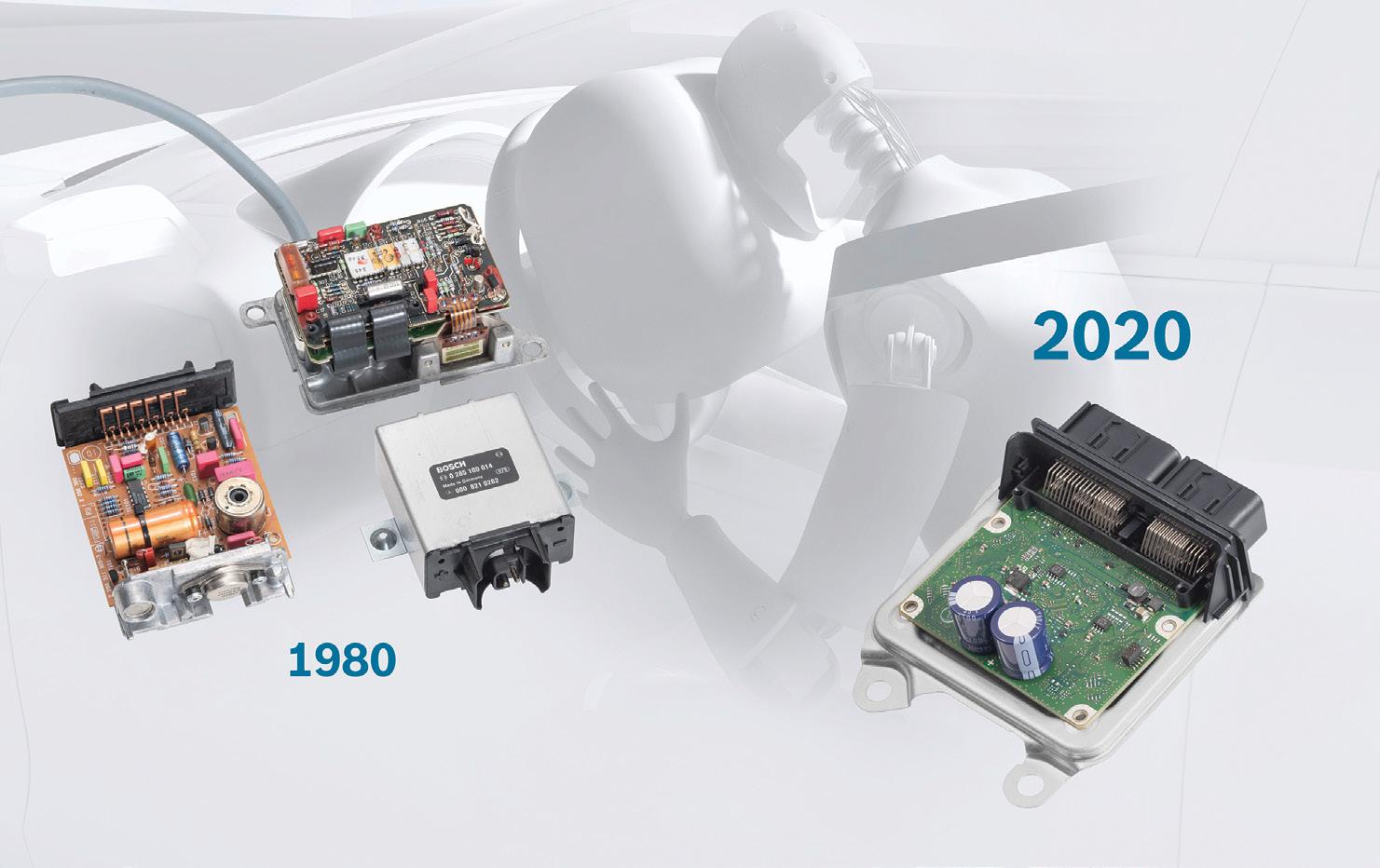
4 minute read
R&D - Bosch - Groundbreaking passenger protection
GROUNDBREAKING PASSENGER PROTECTION
40 years ago, Bosch launched the electronic airbag control unit for cars
A collision, a loud bang, and the worst-case scenario has been avoided – that is the easiest way to describe the benefits of an airbag. Playing a key role in this protective “detonation” is the airbag control unit. It functions as the control center for the lifesaving inflatable cushion. Forty years ago, Bosch joined forces with the Daimler-Benz AG to start production of the world’s first electronic airbag control unit – giving a decisive boost to passenger protection. “Bosch is a pioneer in automotive electronics and safety,” Bosch Board of Management Member, Harald Kröger, said. “The electronic airbag control unit shows what we mean by ‘Invented for life.’” Since the start of full-scale production in December 1980, Bosch has manufactured more than 250 million airbag control units, constantly refining the technology all the while. The company’s accident researchers estimate that since the market launch of Bosch’s airbag control units, the front, side, and head airbags they deploy have helped save some 90,000 lives around the world. This makes them a key component of vision zero: no fatalities or serious injuries in road traffic.
The right decision in milliseconds
Using internal and external acceleration, yawrate, and pressure sensors, a state-of-the-art airbag control unit identifies the type of accident as well as its severity, and deploys the airbag and belt tensioner as needed. In just ten milliseconds – ten times faster than a person can blink – the trigger algorithm interprets the sensor data to determine whether the driver has simply hit the brakes, bumped into a parked car, jumped the curb, or if the vehicle has had a severe collision or is at risk of rolling over. If the situation is dangerous, the system ignites the pyrotechnic gas generator. Within 30 milliseconds, the airbag is fully inflated and can protect the driver and passengers. Today’s vehicles come with as many as nine airbags installed, which can be deployed individually depending on the accident scenario. Following a collision, the system also sends a signal to cut off the fuel supply, or, in electric vehicles, to disconnect the high voltage battery. In addition, the system forwards information about the accident to other vehicle systems – for example eCall, which automatically calls emergency services after an airbag has been deployed. Since 1977, Bosch engineers have worked with automakers on the first electronic airbag control unit, putting it through more than 6,000 crash tests in 60 vehicle models. Today, more than 1.8 million crash simulations are necessary to prepare an airbag control unit for large-scale production in a vehicle model.

The first airbag system, which went into production in December 1980 and then had its market launch in the Mercedes-Benz S-Class, consisted of three components – a voltage converter, an energy reserve, and a control unit – with a total of 170 parts. These controlled only an airbag and belt tensioner for the driver and optionally for the front passenger. Today’s twelfth generation airbag control units have just half as many parts and can manage up to 48 restraint devices, including various front and side airbags, knee airbags, and belt tensioners.
Airbag control units and automated driving

In the future, as the number of sensors in vehicles rises, applying the information they gather could ensure that airbags, belt tensioners, and other vehicle functions interact even better. Such an interaction might look something like this: the system swiftly recognises an impending accident and, for example, automatically puts the occupants into a sitting position that reduces their risk of injury before the actual collision. It can deploy airbags and belt tensioners to provide the best possible crash protection for every person in the vehicle. Increasingly automated driving is one area where these possibilities are relevant, since at higher levels it opens up entirely new interior concepts and more room to move about, even for drivers: they may swivel their seat, turn to face the passengers, or get cozy in their seat. As seating arrangements in the vehicle become more flexible, it is ever more crucial to have very specific control of airbags and belt tensioners. In turn, this increases the complexity of the demands on the airbag control units that Bosch is already working on today. Even after 40 years, this particular bag of tricks is still far from empty.
For more from Bosch, visit www.bosch.com.au

Australian Automotive Aftermarket Magazine Publisher, Cameron McLachlan, takes a look at the products driving the automotive aftermarket. cameron@aaaa.com.au













